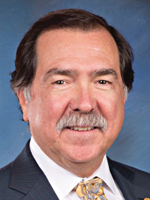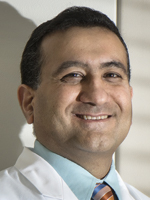Valerie Neff Newitt
August 2017—The age of FDA-approved whole slide imaging for primary diagnosis has dawned with opportunity for every level of professional who works in the digital pathology environment. It includes not only an expanded professional cachet but also great potential born of collaborative and remote capabilities, and perhaps better patient outcomes as a result.
Yet with this new technological sunrise come “environmental” demands: a requirement for excellence in specimen and slide preparation along with a heightened need for standardization of and adherence to best practices and training to ensure the digital pathology sun never sets. While the kinks are not yet worked out, digital pathology technology is likely to help improve the processes on which it relies.
Ivo Van den Berghe, MD, director of surgical pathology at AZ Sint-Jan Bruges Hospital, Belgium, was an early adopter of the digital pathology platform and says he has “seen firsthand how to achieve maximum benefit.
“I have observed how digital pathology enables the lab to replace the subjective nature of manual slide inspection under the microscope,” he says, “enhancing clinical confidence in my histopathology colleagues and our findings.”
Yet Dr. Van den Berghe and others who spoke to CAP TODAY after the FDA approved Philips’ IntelliSite Pathology Solution for primary diagnosis also recognize the need for labs to sharpen their skills and standardize processes to align with digital pathology. “Certain existing practices do have to change if we are to achieve confidence in the standardization of our results, and setting new parameters for quality control is essential,” he says. A starting point for this, he adds, has to be the quality of H&E-stained slides. “Requiring good quality here is paramount to being confident in the results and making a positive contribution to improving outcomes.”
Eric Glassy, MD, president of the Digital Pathology Association and medical director of Affiliated Pathologists Medical Group in Rancho Dominguez, Calif., sums up an industry dilemma. “One of the big problems is that there is a lack of standardization in histology. The CAP has an excellent book on quality assurance in anatomic pathology by Drs. [Jim] Zhai and [Gene] Siegal, but the focus is not on slide prep and its effect on whole slide scanning. We need to develop best practices for creating an H&E slide. Fixation, embedding, sectioning, reagents, staining, and, finally, coverslipping all need policies and procedures that are tissue-specific and use-specific when a lab adopts whole slide imaging.”
Anil Parwani, MD, PhD, MBA, vice chair of anatomic pathology, director of pathology informatics, and director of digital pathology shared resources at Ohio State University Wexner Medical Center, explains the problem further. “Because histology processing aspects are so variable, an H&E stain differs from one city to another, one facility to another, and even one lab to another within the same facility. If given the exact same tissue, the slides still all look different because of varying concentrations of hematoxylin, varying lots, varying manufacturers, etc. And then there are also differences brought on by pathologists themselves. Some prefer their slides to appear more blue, others prefer them more pink.”
Dr. Van den Berghe believes support from manufacturers like Philips can help solve the problem. “H&E quality can best be achieved with the supply of autostainers which set out the lab’s contractual obligations on quality—removing subjective decisions. This indicates precisely how many H&Es can be safely stained before the color containers must be refreshed. Previously,” he says, “we were able to use the color containers until it was decided that quality had started to decline. For digital pathology, this subjective process should be actively discouraged.”
Why does digital pathology ratchet up the importance of optimal tissue and slide preparation? Once tissue is captured in a digital image, its focus is static. When a slide with air bubbles, folds, or other artifacts is viewed under a light microscope, it is “not necessarily a good thing and yet it may not have a major impact on the assessment of those sections,” says Zoltan G. Laszik, MD, PhD, medical director of renal pathology and director of digital pathology at UCSF Medical Center, San Francisco. (Dr. Laszik was instrumental in designing the 2014 validation study that contributed to FDA approval of the Philips system.)
“But folds and bubbles create uneven thicknesses in a specimen, which can trick a scanner into focusing on the height of the fold, for example, leaving other clusters of cells out of focus,” Dr. Laszik cautions. “What if those clusters of cells contain cancer? Since there can be no refocusing of a digital image, the solution is to have very high-quality sections. That is a requirement of digital pathology.”
For frozen sections, Dr. Laszik says there is one adjustment that must be observed when preparing the slides for digital versus traditional interpretations. “The coverslipping must be changed. The conventional glass coverslipping utilizes a glue that can contaminate and jam the scanner. For that reason, labs using glass coverslipping need to change to plastic to preserve the integrity of the scanner.” It will not change anything in the tissue, Dr. Laszik says. “It will just keep your expensive equipment up and running. And that will keep your administrators happy.”
He calls this solution “absolutely crucial”: “Without it, [scanning frozen sections] would never work well. It is a key step.”
While improvements in slide preparation are important, Dr. Laszik says, they generally do not require significant changes in practice. Rather, they require adherence to what was needed all along: strict quality control. “We must do exactly what we always were supposed to do: create high-quality sections that are placed into the middle of the glass slide, that are not fragmented, that don’t have folds, and that do not have bubbles.”

Dr. Glassy
Dr. Glassy, too, stresses that a poor glass slide equates to a poor digital image. “Departments must develop policies and procedures to properly orient the tissue to the slide that will be scanned. We need to be mindful of embedding—if there are multiple biopsies they are often haphazardly arranged in a block. For digital scanning it is better if they are all lined up,” he advises. And it is important to be sure that tissue is sufficiently trimmed so it does not go to the edge of the slide, “because scanners do not scan to the very edge.”
Thickness of a section makes a difference too, Dr. Glassy says. “Too thin or too thick leads to darker or lighter staining. Uneven sections will result in out-of-focus scans. And while pathologists using conventional microscopes are pretty forgiving in being able to focus through folds and irregularities in the tissue, in digital pathology everything is in a universal focus frame. Issues with poor sections will simply be magnified by digital imaging.”
Digital images are more demanding of high quality, and pathologists and histotechnologists need to be keenly aware of that, Dr. Glassy says. “If you are going to be implementing digital pathology, histotechs must have quality control processes in place so that the final scan is the best it can be.”
Fortunately, it appears that the technology that drives digital pathology may itself play an important role in improving slide and specimen quality. It is a fact that is not lost on Carolyn Compton, MD, PhD, professor of life sciences at Arizona State University, professor of laboratory medicine and pathology at Mayo Clinic College of Medicine, chief medical officer for the National Biomarkers Development Alliance, and chair of the CAP’s Preanalytics for Precision Medicine Project Team.
With a professional interest in ensuring that biomarker specimens are of sufficiently high quality to be reliable, she decries the lack of standardization that has been apparent in the preanalytical phase of specimen preparation and explains the problem as she sees it. “In the practice of pathology we bend over backward to make sure things are done right. We standardize the laboratory environment for tests and seek CLIA and CAP accreditation. We standardize the assays. We test proficiency of those who perform tests, and we do a lot of quality assurance. But we have no enforced standards for the very thing we are testing. For me it is inexplicable.”

Dr. Compton
Dr. Compton notes that variations in the fixative, for example, can affect the downstream analyses of these tissues. “What we want is a standard fixative, 10 percent neutral phosphate-buffered formalin, that is carefully quality controlled, because it preserves both morphology and a whole range of biomolecules quite well. This ties to the digital piece because if you use alcohol fixative, for example, which fixes by dehydration and denaturation in contrast to formalin, which fixes by cross-linking of molecules, the results will be different. Alcohol causes subtle changes in the nuclear morphology because it causes DNA to collapse, as well as cytoplasmic changes because it produces protein coagulation and cell shrinkage. But if you have a rock solid standard against which your digital technology can do quantitative measurements, you’d be able to detect samples that would be inappropriate for analysis because of preanalytical factors.”
Total time in formalin must also be standardized. “No less than six hours and no more than 24 to 36 hours. Improper fixation time can result in either under-fixation with inadequate molecular preservation or over-fixation with molecular damage,” Dr. Compton says, “even artifactual mutations in the DNA. The fallout could be tremendous: the wrong answer on a molecular analysis.”
Dr. Compton believes digital pathology may hold the key to improving specimens. “Some of the preanalytical steps cause artifacts in tissue that may be difficult or impossible to detect by the human eye on a glass slide. But if digital pathology were to use its power to detect subtle changes in morphology or tintorial properties and compare those to a standard, it could then flag specimens that are unreliable for biomarker staining, detection, or analysis and alert us that they have been compromised in the preanalytical phase,” she says. “That would be a huge leap forward.”
Dr. Compton says pathology is just beginning to uncover the myriad benefits within digital technology. “I don’t know exactly where digital pathology will fit in,” she concedes, “but I do think it is a more precise tool to determine specimen acceptability than just doing it by the seat of our pants. We are still very early in the discovery mode with respect to digital pathology. Its potential is not yet fully unlocked.”
Others agree with that premise of expanding utility. Dr. Glassy says digital imaging brings into play additional quality control supports, ones that technologists are accustomed to in clinical labs. “Tools, graphs, and Westgard rules can now be implemented within histology. Whereas before histotechs did not have a good measurement of the quality of their stains, digital imaging allows that to happen.”
A laboratory can establish and install rules and algorithms within its technology to flag something out of range. “That kind of scientific rigor is being applied to what was before a purely manual analog process. It allows us to quantitate how things have changed. Are your sections too thick? Are your immunohistochemical stains still at the same intensity they were a month ago when you first opened the lot of reagents? These things are not easily determined by a histotechnologist or a pathologist who is looking at a slide. But a digital scanner can measure the intensity of the staining from day to day, and that can be plotted out on a graph. Some labs are doing this now. It’s easy to implement,” Dr. Glassy says.
Optimizing such capabilities will require training that emphasizes workflow adjustments and observance of quality control.
“Workers will need to understand required changes to the workflow; that is part of the frozen section story in diagnosis,” Dr. Laszik says. “You cut the section, you coverslip them, and in the old model you delivered that to the pathologists who were sitting nearby and looked at the slides. Now you need to scan them, and what if scanning goes wrong? What are the backup solutions? How many times do you need to rescan those slides? If you cannot get it in focus, do you need to cut new sections?” These are some of the issues that should be addressed from a workflow standpoint, he says.
While its early track record is impressive, digital pathology is not a perfect science, and laboratories must be prepared for the imperfections that may arise, albeit infrequently. Digital pathology was introduced in Dr. Laszik’s lab in early 2015 for frozen sections, and he and colleagues devised a backup solution in the event something were to go awry. “We have three hospitals and all three have ongoing operating rooms with frozen sections, scanners. We realized we could use one person instead of three to read frozen sections,” he says. “But we also had the luxury of an on-site pathologist who could cover in case of a problem with the scanner or a bad scan. Yet I can say that since we started to do these in 2015 there was not a single case out of hundreds of cases that required something that would be extraordinary. There were, however, a few cases that required an on-site look at the case. So you must be prepared for even one case.” If there is no pathologist on site, one alternative backup solution could be a live WebEx session, he suggests.
“The only way to make people aware of best practices for specimen and slide preparation and troubleshooting the unexpected that may arise is training, training, and more training,” Dr. Laszik emphasizes. “Train your people, monitor the quality all the time, and give them feedback. It is an old-fashioned approach, but it is even more significant in the digital age than it was before.”

Dr. Parwani
Dr. Parwani, too, sees greater QC potential in the technology that drives digital pathology. “Digital pathology is an enabling technology,” he says. “Until now there was no objectivity; pathology was an art rather than a science. But now we have measurable levels of standardization that we can take advantage of. We can run a computer program with a lab’s own rules for an acceptable quality threshold. We can add a number to it and give an image a quality score. Any image that does not meet a predetermined measure fails. Furthermore, we can review images that come out of the histology lab and provide instantaneous feedback to histotechnologists. This creates a dynamic feedback loop into the lab.” When slides are digitized, he says, true collaboration is possible. “This is the beauty of digital slides: We can manage workflow and make everything more streamlined in terms of image management, image sharing, and image analysis—three things we could not do with glass slides.”
Laboratory staff can be educated and processes improved at the same time, Dr. Parwani says. “That is very, very powerful.”
The associated utilities of digital pathology, bolstered by underlying, high-quality histotechnology, seem to have no observable limit on the horizon. “It’s like a pyramid,” Dr. Parwani says. “We are at the very bottom of the pyramid now where we are seeing more and more labs starting to digitize their slides. Once the base of the pyramid is filled with images, we can build on it. We can expand in the areas of research, companion diagnostics, quality assurance, education, consultations. The sky is the limit.”
[hr]
For histotechnologists and pathologists, a Digital Pathology Certificate Program
A new Digital Pathology Certificate Program, a collaborative effort of the National Society for Histotechnology and the Digital Pathology Association, is expected to roll out this fall.
“NSH realizes that digital pathology is becoming more important and that the tasks of keeping scanners working optimally, maintaining proper validations, etc., generally falls to histotechs,” DPA president Eric Glassy, MD, says. “NSH hopes to recognize the extra interest and hard work their members are providing in support of digital pathology, and wants them to be recognized as imaging technologist specialists.”
The course is suitable for others who might want to achieve the same competence. “This is not just histotech focused. It is for pathologists as well, who may wish to be certified in proper use of whole slide imaging scanners,” Dr. Glassy says.
To earn the certificate, participants in the program will complete seven modules: introduction and history of digital pathology; basics of the technology—hardware/software; use cases; implementing and selecting a digital pathology solution; workflow considerations/best practices; image analysis; and regulatory/validation.
The course will be the topic of a panel discussion at the DPA’s Pathology Visions meeting in San Diego, Oct. 1–3.
Also noteworthy among training efforts, says Dr. Glassy, is a forthcoming module within the CAP/NSH HistoQIP program that will allow the grading of a digital scan. “The hope is to unveil it early next year,” he says. “Right now criteria for how scans should be evaluated and properly graded are being developed by two CAP committees. Eventually there will be two types of proficiency testing—one a virtual HistoQIP program and the other an evaluation of the scan.”
For histotechnologists, this will serve to validate they are performing to a high standard, Dr. Glassy says.
“And this will really expand the reach of the HistoQIP programs. This is a worldwide program; other countries may submit slides for evaluation.” The reach of digital pathology has already taken existing HistoQIP modules to countries that formerly could not participate—China, for one. “No human tissue may leave the country, so Chinese lab professionals can’t send out paraffin blocks or glass slides,” Dr. Glassy says. “But because DP scanning centers have been set up, HistoQIP can now move into countries that limit how slides can be sent for grading.” —Valerie Neff Newitt
[hr]
Valerie Neff Newitt is a writer in Audubon, Pa.